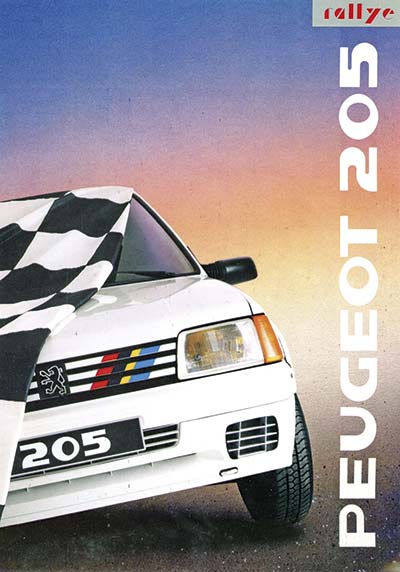-
MenuBack
-
COLLECTIONS
-
-
24h00 Le Mans
-
Alpine A110 1600S
-
Lancia 037
-
-
-
FULL KIT
-
-
FULL KIT
-
-
- ACCESSORIES
- Australian
- MAQMADON
-
Assembly guides
-
-
Blog Ixo
-
- FAQ
The Peugeot 205 Rallye of 1988
When Peugeot-Talbot Sport started designing the 205 Rallye at the beginning of 1987, Jean Todt included the idea of homologating it in Group A and N. In order to comply with the regulations for this category, it was planned to produce a series of 5,000 examples for the general public. The success of this version with its disconcerting efficiency and agility was such that 30,111 examples were produced between 1988 and 1992. The recipe for this remarkable performance lies in the installation of a perfectly prepared 103 hp engine in a chassis that is lighter than that of its larger GTI sisters.

A 205 Rally Cup was created in 1990, taking place on a circuit and comprising 9 different events.
© IXO Collections SAS - Tous droits réservés. Crédits photo © Peugeot
The third way
At the beginning of 1987, the Peugeot 205 GTI 1.6 and 1.9 had been selling like hotcakes since their successive launches in 1984 and 1986, when information began to be revealed in the press concerning the forthcoming marketing of a 205 "Rally". This more economical model would not be part of the GTI line, but would be positioned just below the 1.6 version with 115 hp. It would take the place of the 105 hp 1.6 version which had just been withdrawn from the Peugeot catalogue. At that time, there was too much of a gap between the real GTI sports cars and the more muscular models of the classic 205 range, namely the GT and XT versions which had a power of barely 80 hp. For this intermediate model, it is also a question of finding a high-performance engine with a displacement of less than 1.3 litres, in order to comply with Group A and N regulations in the under 1,300 cm3 class. The idea is to offer amateur drivers a vehicle capable of competing in these two categories of motor racing at a lower cost.

The 205 Rallye's catalogue clearly expresses its sporting character with the chequered flag and marking in the Peugeot Talbot Sport colours.
© IXO Collections SAS - Tous droits réservés. Crédits photo © Peugeot
A sharpened engine
The choice of engine was to be the new 4-cylinder Type TU24A with 95 bhp which equipped the AX Sport launched in 1987. With a displacement of 1,294 cm3, this 4-valve per cylinder unit was improved by the tuner Danielson who fitted it with two large Weber twin-barrel carburettors, a more direct intake manifold and a larger airbox. The effect is immediate: power rises to 103 bhp at 6,800 rpm for a maximum torque of 12.2 m.kg at 5,000 rpm. The performance of this new version, called TU24A/K, is 80 hp/litre. The 5-speed transmission, type MA 5 SR, has much shorter ratios. It is coupled to a dry single-plate clutch (diaphragm) of the Valéo Verto type with a diameter of 18.15 cm. The drivetrain is installed as usual, transversely at the front and inclined 30° towards the rear. The bodywork of the 205 Rallye is identical to that of the other 3-door versions, it is only available in Meije White. The braking and suspension components are taken from the 115 hp GTI, except for the dampers which are specific to the GTI.

The Peugeot 205 Rallye is not a low-end GTI, it was born for racing, in the tradition of small sports cars such as the R8 Gordini or the Simca Rallye.
© IXO Collections SAS - Tous droits réservés. Crédits photo © Peugeot
Amazing performance
The car has been seriously lightened (about 30 kg) by stripping it of all superfluous equipment in the cabin and on the body and the power-to-weight ratio is now 7.7 kg/hp, which gives it good handling. The result is that it manages to complete the 1,000 metres from a standing start in 30.8 seconds, while the 0 to 100 km/h is set in 8.8 seconds, with a top speed of 190 km/h! The purchaser of the 205 Rallye can thus be satisfied with performances really close to those of the 1.6 GTI version of 115 hp and this, with a notable difference in price: respectively 69 800 francs and 85 800 francs for the 1988 vintage. For comparison, the 130 hp 1.9 GTI version was sold for 94,400 francs that year. Thanks to its exceptional price/performance ratio, the Peugeot 205 Rallye was awarded the title of "Sports car of the year" in 1988 by the magazine "Echappements". The 205 Rallye was marketed for export, where modifications were sometimes made. In England, it was offered in yellow with a 75 bhp TU3 engine, while in Germany and Switzerland, it was equipped with a 105 bhp XU9J catalyzed engine.

Presented as an economical sports car, the 205 Rallye was able to sacrifice superfluous equipment without giving up performance.
© IXO Collections SAS - Tous droits réservés. Crédits photo © Peugeot
Share this post





 Français
Français Anglais
Anglais Allemand
Allemand Espagnol
Espagnol Italien
Italien Portugal
Portugal